Don’t freak out
Sand flies. Lots of them. That’s what we found waiting for us on the south island’s West Coast. We’d been excited to finally see the ocean for a bit, so we pulled over and hopped out at Bruce Bay, the first place the highway runs near the ocean.
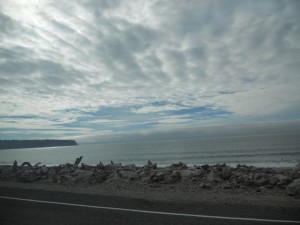
It was beautiful. I trotted toward the restroom (New Zealand is amazing about public restrooms), while Krista snapped a couple of pictures.
Honestly, I don’t remember if I made it. The bugs were so thick and aggressive that, even with long pants and sleeves, I was being bit. The both of us bolted for the van, and climbed inside, dusting the buzzing things off of our heads.
I felt Krista stop and I looked up. She was staring at me. “Try not to freak out.â€
Here’s a free piece of advice: if you are hoping that someone who is not currently freaking out won’t suddenly begin freaking out, alerting them that there is, in fact, a reason to freak out, will not help your cause.
I looked down toward our laps, and saw probably a hundred sand flies floating, flying and crawling around.
“How am I supposed to not freak out?! How?!â€Â I was beginning to unravel. I am one of those super-fortunate people that attracts biting insects to my lovely sweet blood. I already had half a dozen welts beginning to form, and now I found myself sitting in a nest of nasties.
Krista began swatting. Neither of us wanted to open the windows. They were coated with the flies, too, inside and out. So we drove. She swatted and we cracked the windows to try to flush them away from us even inside the van.
“I don’t think we’ll be spending a lot of time on the West Coast,†came Krista’s flat voice.
Eager to reach a stopping point, we headed to the first camp site we had our eye on, Lake Paringa. It was off the ocean, and up a bit, giving us hope that the fly situation might be a bit more manageable. When we stepped out of the van, however, it was clear this wouldn’t be our refuge. At least this time we were a little more prepared. I managed to take a couple of pictures while running to the back of the van.
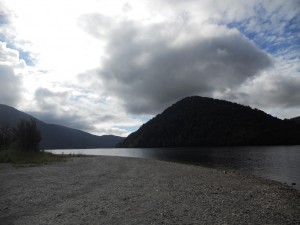
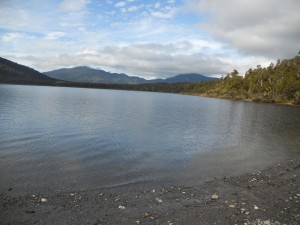
I threw up the back hatch and grabbed the hand-broom. Then I brushed and scraped as many of the flies as possible off of the rear window, trying not to let them fall on me.
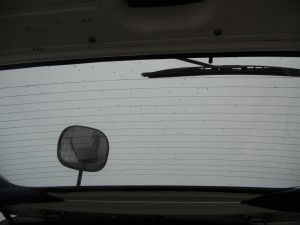
With Lake Paringa in our rear view mirrors, we cracked the windows again and pulled the map out of the glove box. Haast Pass. That was what was in front of us. We were tired, but we were not interested in the flies. Their bites were tiny, but turned quickly into itchy, puffy, red welts. Not fun.
“Maybe if we get up higher, we won’t have as many.â€Â Krista was trying to find us a bit of comfort. “We didn’t see any in Arthur’s Pass. You up for a drive?â€
We wanted to be in Wanaka the next day anyway, which meant driving the pass tonight or tomorrow. The sooner we were through the bugs, the better, in my mind, so we set off for the pass. There were several camp sites there. We’d pick the one away from water and see what happened.
What happened is that we jumped out to make dinner just before sunset. The flies were few and far between, except for those Krista knocked off the back window from our last stop.
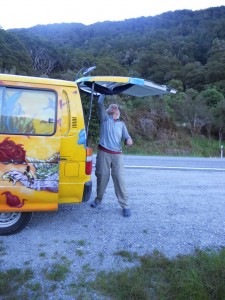
Lulled into a false sense of security, we started cooking, and even pulled out some camp chairs to sit in. Mistake. Almost the second we sat down, the flies were on us. Less interested in our food, than our skin, they tried to find chinks in our armor.
Dinner became a walking affair. We paced and ate and quickly realized that this was not our refuge, either. The tourists around us smiled curiously as we threw the stove in the back of the van and headed out again, still tired, and wondering how the others were managing to sit outside.
The drive into the pass was beautiful, marked by towering mountains, shining rivers, and rock-laden waterfalls.
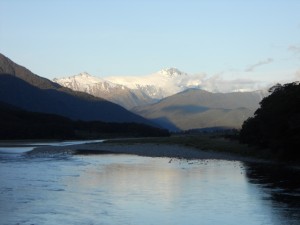
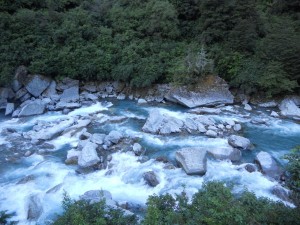
When we reached the next campsite, dusk was falling. We talked for maybe a minute about driving through to Wanaka, another hour and a half up the road. But we were done for the day. Glaciers and sand flies had worn us out.
This site was on a hill, above a river.
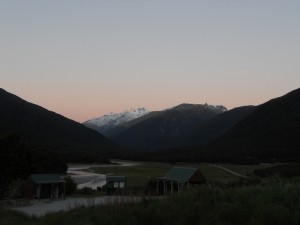
The views were spectacular and quiet, but the river meant flies. We weren’t over the pass quite yet. It was, however, time for evening tea and games. I braved the flies to make our tea, pacing quickly, while Krista commandeered a dirty sock to rid the van of our guests.
When I climbed back in with our hot water, I was a little afraid. “This is the killing sock,†she stated flatly.
“Okay. Thanks for doing that. I don’t really like killing things.â€Â One fly buzzed past my face. “Ahhhhh! “ She reached over and squished it with her fingers.
“Thanks,†I said again. These bastards were seriously challenging my feelings about killing living things.
We played a game or two of cribbage and drank our tea. Then we prepared for bed, climbing under and over the bars that separated the cab from the sleeping area. We discovered that we could do almost everything we needed in the van, without having to open the door – everything except for peeing, unless we wanted to use the sink. Finally, we climbed under the covers, shaking the dead carcasses to the edges of the comforter, and turned off our headlamps, which had attracted swarms to the van windows.
“We’ll have breakfast in Wanaka tomorrow?†Krista asked, more confirming than questioning.
“Sounds good. Be careful if you get up in the night to pee. Nobody wants those bites.â€
January 8, 2011 1 Comment
Glaciers!
When I decided to go to New Zealand, it was on short notice, with very little research.  I was filling in, so I hadn’t studied maps or routes. I had, however, visited the Polynesian Cultural Center in Hawaii, and seen all of the Lord of the Rings movies several times. This gave me the impression that I would find amazing, tattooed warriors playing rugby with elves. This wasn’t entirely true.
One thing I didn’t realize is how close the South Island of New Zealand is to Antarctica. This geo-position became more and more clear as we drove further south. Lush forests and tropical-looking plants remained, but now they gave way not only to mountains, but to glaciers. Glaciers!
Yes, I’ve been to Glacier National Park. I’ve walked out onto the snow and ice, next to lounging mountain goats. But something about New Zealand is more. Not the way Rome is more with its lights and bustle. Not the way Texas is more with its big. New Zealand is more in its ruggedness. It feels like the wild west. Like driving our little campervan around the country was an expedition. As though we could, at any moment, discover a velociraptor in the undergrowth.
Our first stop for glacial admiration was the Franz Josef glacier.  We drove into the park, past signs that told us where the glacier was 200 years ago, 100 years ago, 25 years ago, and into a lot full of vans. As usual, ours was the most interesting – save the ICEBREAKER van parked down the way!
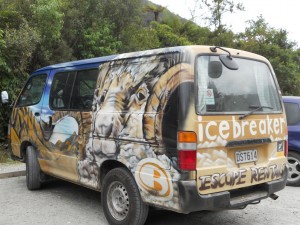
I flashed a smug smile, counting how many layers of the merino sweaters I was wearing as we passed, entering a thick canopy of dense trees.
The alder enveloped us, tall, thin trunks reaching up, covered in the white lichen that indicates extremely pure air. Stepping out a short while later, we found ourselves faced with a naked, scouring wind rushing across the glacier and down the valley. And opposite us, the glacier.
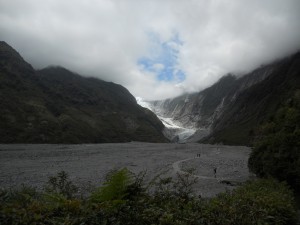
The trail took us out across the glacial valley, over the rocks ground down and deposited by the retreating ice. Waterfalls surrounded us, falling gracefully and freely from the steep valley walls, creating micro vistas of startling beauty.
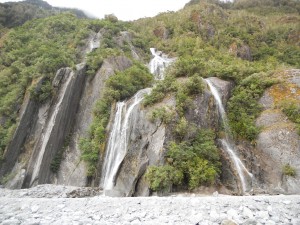
As we approached the glacier took shape and color, transforming from black and white to shades of blue.
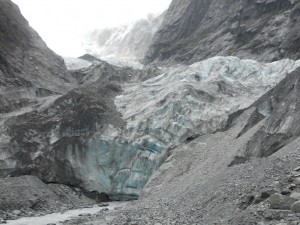
A rushing sound intensified, now less the sharp lines of the wind, and more the rock-shaped sounds of water moving hard, pushing up from the bottom of the glacial face.
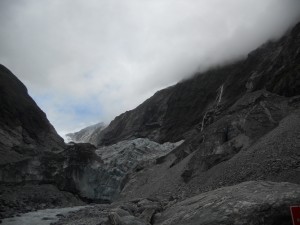
The water was nearly unnoticeable until we got close. It was the color of the rocks, its shape masked as it ran through the rubble, following a course that appeared haphazard, ready to change at a moment’s notice. Posted signs gave testament that the glacier could, in fact, change itself and the river in a metamorphosis of rock and ice gushing forth into the valley.
Sufficiently awed, we turned back to the trail.
Though our next destination was the Fox glacier, we took a recommended detour to a nearby lake known for its amazing reflected views of the surrounding mountains. Though the trail was littered with interesting flora, the lake itself was unyielding. The clouds had come in, leaving no mountain views, and perhaps the only less-than-perfect weather day of the entire trip.
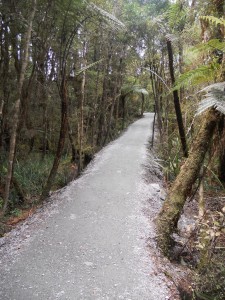
We acknowledged the excellent fern trees and made a run for the car as drops began to fall from the sky.
By the time we reached Fox Glacier, the rain had cleared, leaving a foggy residue clinging to the edges of the valley.
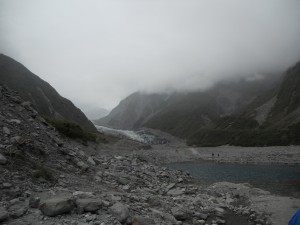
While our last lake experience had been a bit of a disappointment, Fox brought us a watery surprise.
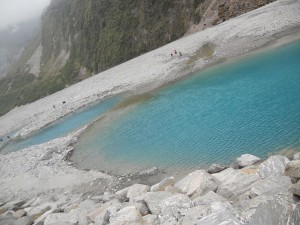
Lakes, eerily blue, greeted us at the trailhead, our first experience of the glacial blue waters of New Zealand.
This glacier allowed us closer, more textured views.
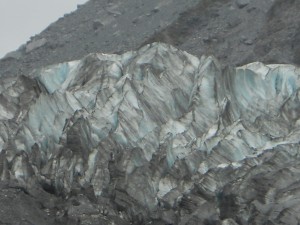
The experience was cold and stark and strangely peaceful. Which was good, because 20 minutes later we found ourselves running from swarms of sand flies on the West Coast. Literally running.
January 6, 2011 Comments Off on Glaciers!
Arthur’s Pass
There are a couple of things that one must realize about traveling by campervan. Depending on the kind of van you have, you’ll have certain amenities. And you won’t have others. Ours, for instance, had quite an adequate kitchen area. The cooler stayed cool, and we were able to cook great meals on the camp stove. We did not, however have any kind of bathroom facility.
During our two weeks on the south island, we had two showers. That’s all, just two. Neither of those took place on day two.  Even with the drapes pulled around our little bedroom, we woke with the sun, slowly and steadily working our way into a conscious state.
Krista, who had already been traveling the north island for two weeks, was in full-out adventure mode. “I’m thinking about a bath in the lake,†she declared, beginning to strip down the morning layers.
Appalled, I crawled deeper under the covers. I like being clean, but the idea of a morning dip in a glacial lake wasn’t the kind of adventure I was quite ready for. I require a bit of warm before hurling my naked body into freezing water.
And so, from my warm perch inside the van, I watched as more and more skin appeared, and Krista walked out into the water.
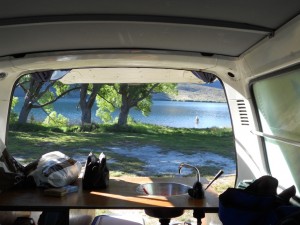
(Yes, of course I took a picture. Don’t worry, there are plenty of compromising shots of me…)
After a good shimmy and shake, she emerged, smiling and clean. I shuddered, and pulled my hood up over my ears.
Day two meant that it was my turn to drive. I was looking forward to the challenge. The gas and brake pedals were in the same configuration as in the states, but the steering wheel was on the opposite – as were the windshield wipers and turn signal. I’ll say that there were only a couple of moments when Krista had to yell, “wrong side!†to get me onto the right side of the road, and I only tried to climb into the other side of the cab a few times. However, I activated the windshield wipers approximately 24 times every day, while trying to signal.
As we drove on, with an exceedingly clean windshield, we delved deeper into the beautiful New Zealand countryside. We climbed higher, working our way to the pass. Unreal landscapes presented themselves to us over the edge of the road, perched along the mountain.
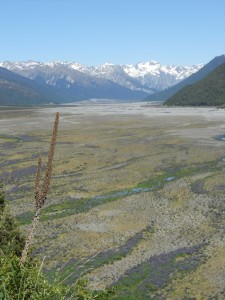
Mullen, scotchbroom, water, mountains and lupine stretched in fingers below us, the foliage following the waterlines of glacier-fed streams that led from the distant, snow-capped mountains.
As if in response to the flora, and not wanting to be outdone, the fauna began asserting itself.
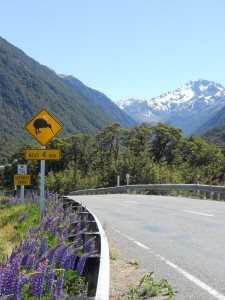
Kiwi bird crossing signs popped up, and while we were out photographing the landscape, a large, brown-green bird landed on the roof of the van and stuck its head inside.
“What was that?!†I’d looked up to see it land on the van, 20 yards away from us, up an embankment. “Something big landed on the van. I’ll go check it out.â€
I scrambled up, wondering what I’d just seen. It had appeared to be checking out the open window, but fluttered to the ground when I walked toward the van.
“No way.â€Â I was looking at something completely unexpected.
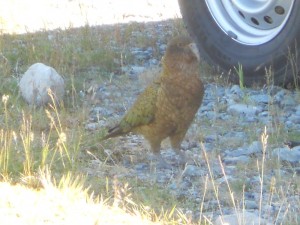
“It looks like a parrot!â€Â I yelled back to Krista who was now climbing up as well. “I didn’t know there were parrots here.â€Â We both looked around at the mountains and then back to the bird.
He was friendly, and seemed as curious about us and our colorful van as we were about him. He stayed in the shade of the van and turned his head back and forth looking at us. One of the people Krista had stayed with on the north island was a zookeeper who had showed her something similar. We were both excited to confirm what we were seeing when we hit the next ranger station.
When we described what we’d seen to the smiling ranger, he pointed, without looking, at a picture on the wall. Sure enough, it was a Kea, the only alpine parrot in the world. These guys are known for being social friendly, and mischievous, famous for removing the rubber parts off of cars, and stealing anything they can from campsites.
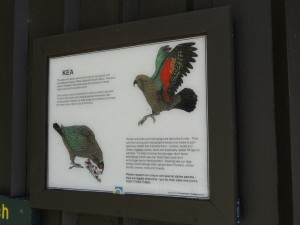
Along with the Kea confirmation, the ranger gave us directions to a couple of different walks that would take us into the Arthur’s Pass wilderness, and waterfalls.
The first was a towering two-tiered fall. We walked the half mile up, seeing a couple of other hikers. The falls were beautiful, and we climbed down to the pool below for a closer look.
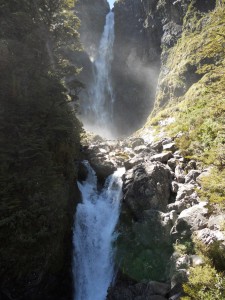
Coming from Oregon and Idaho, comparisons were almost unavoidable. The falls looked like Multnomah Falls, a well known set in the Columbia Gorge of Oregon. We took our pictures and moved along.
Our next hike would take us further in, closer to the mountains, past alpine lilies, and a gorgeous tumbling river.
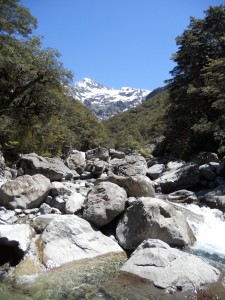
Soon enough we found ourselves facing a series of large rocks, falls and pools.
“Shall we cross?â€Â The question was barely out of Krista’s mouth before we were picking our way across the river. Once across we clambered up the bank, working our way toward the larger pool.
“It looks pretty deep.â€Â The hot sun had me thinking about a bath of my own.
“It’s not.â€Â Krista’s time as a member of a swift water search and rescue team gave her the ability to tell whether we should be jumping into any rivers.
“Okay, I’ll start lower.â€Â Now, I’m not known as someone who will strip down and throw my naked body into a body of water with other people around, but my sense of adventure was growing, my body was starting to smell like 40 hours of travel, and the clear skies were taunting me.
I looked over to see Krista taking off her shoes. “You coming, too?â€
“Of course.â€
While she waded in, I climbed to the lowest ledge of a boulder on the side of the pool. It gave me maybe a 6 inch drop, but it was enough. I much favor the sudden cold to a gradual freezing.
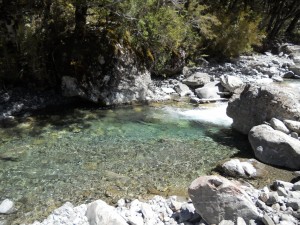
My feet touched gravel, and my head popped quickly out of the water, followed by the rest of me. Krista was still splashing around as I stumbled from the pool. She ambled out, and we worked our way over to the big, flat rocks in the middle of the river. Sun-warmed, the rocks were perfect for drying off. We threw our soggy bodies onto them, and closed our eyes, sighing happily.
I jerked a little when, ten minutes later, I felt myself sliding down the sloping rock. When I’d plopped down, my wet body had effectively adhered me to the slab. Now, as I dried in the sun, I was losing friction and moving slowly to the edge of the rock.
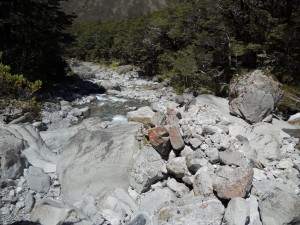
It was then that I looked up from my perch and realized where I was. Naked. In the middle of the river. Fully visible from the trail we’d climbed earlier. Startled, but laughing, I rolled off the slab and looked around. There were hikers below, but it wasn’t clear whether they’d had a chance to see the enhanced view.
I laughed as I gathered my clothing. It was entirely possible that the unwitting hikers would find a surprise if they looked closely at their pictures when they got home.
Well rested, cleaner, and sunned all over, we packed up and headed back, with one last look around at the towering scenery.
We repeated our routine from the day before, scouring the map for a campground and picking our way through the mountains to one that would give us a good start the next day. Lake Ianthe was the winner. While it was a much smaller camp site – barely more than a parking lot on the side of the road – it had running water, a picnic table and a dock.
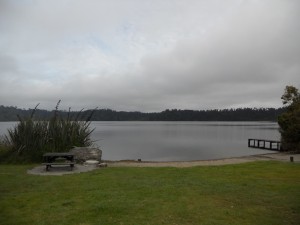
It was here that we learned the true value of our van’s paint job. While a little creepy to us, it was equally creepy to others. In the small campground, we had two separate vans pull in next to us, only to move a short time later. It seemed the van served as vehicle, home, and protective gargoyle, a handy feature throughout the trip.
The lake provided us with another delicious meal, another comfortable place to sleep, and another beautiful sunset.
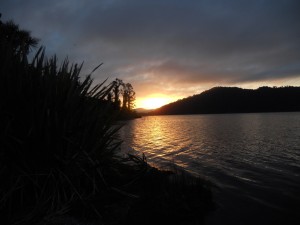
We ate and watched, and laughed about the perfect moment on the rocks in Arthur’s Pass.
January 5, 2011 1 Comment
Fellow travelers
My arrival in New Zealand was unceremonious. After a 12 hour flight and a 5 hour layover in Auckland peppered with fluttering sleep on airport benches, I found myself in the smallish Christchurch airport. Sitting across from 3 espresso stands packed next to each other, I contemplated my recent decision to give up coffee. An hour later, Krista, my NZ travel companion stepped off of a plane, ready for our adventure.
Krista and I had dated for a blink of an eye. The super-heated kind of a thing that leads to illusions of intimacy that inevitably come crashing down the moment reality is introduced. Now, almost a year later, we found ourselves fellow travelers, eager for companionship, and wondering what the next two weeks in the tight quarters of our rented campervan would bring.
The campervan company was one that Krista had picked out months before.  When her travel companion fell through, and I decided to fill-in a month before the trip, Krista sent me the information she had compiled: booking information for treks, maps of the country, and the website for the campervan company. It was the van that was most exciting to me. The vans were hand-painted by graffiti artists, and equipped with a bed, a sink and a camp stove – nearly everything we’d need.
We spent time stalking the vans online, reading their names and descriptions and studying their paint jobs. When we arrived at the rental office, we were excited to find out which of the 100 vans we’d be driving.
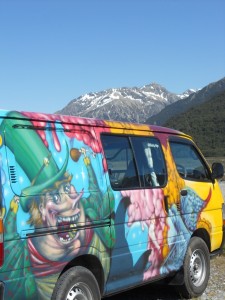
“Elliott’s Trip.â€Â This was the van we would be driving for two weeks. This was the van we would be living in. Cooking in. Sleeping in.
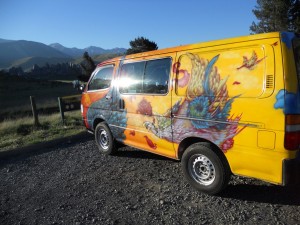
The other side was better – less creepy leprechaun, and more phoenix, but we were still unconvinced. We were hoping for some ancient Maori symbols, or a serene whale.
Undeterred, however, we struck out. Christchurch had some interesting spots. Cathedrals stretched high, and boats punted along the river.
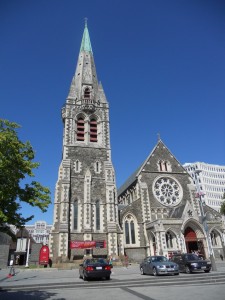
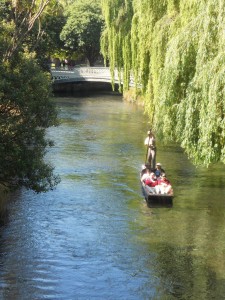
We took a moment to look around, but we had a mission. We were headed into Arthur’s pass, a beautiful stretch of mountains, where we would find a place to camp for the night. After a quick stop to stock our cooler, we headed out of the south island’s largest city, and into the countryside.
The first couple of hours were dominated by ever-lowering fog. We didn’t see much, other than the occasional sheep, until the fog suddenly cleared, giving us a better view of where we were.
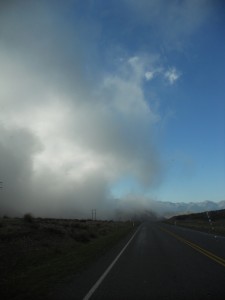
A road sign told us that “Castle Hill†was ahead. Neither of us knew what this could be. It wasn’t on our list of things to see. But we were both up for adventure, and, as we approached, our interest grew.
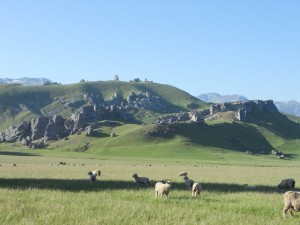
A trailhead led from the small parking lot up into the hills. Groups of sheep and cattle dotted the strange landscape, marked by large, blocky rock formations on the towering hillside.
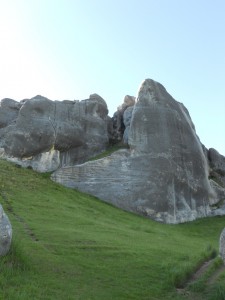
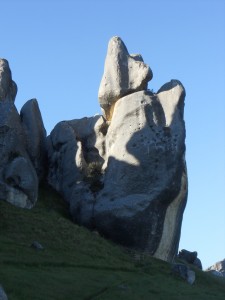
Steep drop-offs and bizarre formations rose up from the ultra-green grass. We walked and climbed and gazed around from a perch atop the rocks, taking in our first real view of the island and its terrain.
Back at the van, we pulled pamphlets from the glove box. The New Zealand Department of Conservation maintained a variety of campsites across the country. If we were lucky, we would be able to use the inexpensive, well kept sites as we wound our way around the island.
We evaluated our energy levels and then picked a campsite from the map. This one would be on a lake, Lake Pearson, and not far from our next day’s destination: a waterfall hike in Arthur’s Pass.
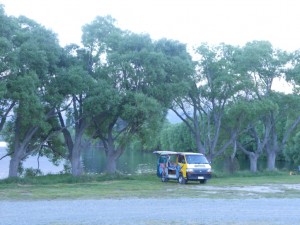
The drive to the lake was quiet. We saw very few cars, and the landscape became more and more rugged. The feeling that we were remote increased with each mile we drove.  We saw Lake Pearson as we approached. It was low and flat, a mirror of the grasslands surrounding it on most sides and the trees on its banks. The hill on one side was pointy and brush-covered, reflecting the freshly-setting sun. Here we found our campground, marked by a small sign, a tent, and another campervan.
Surveying the area, we chose a spot close to the water, and under the trees, where we backed the van in and made ourselves comfortable.
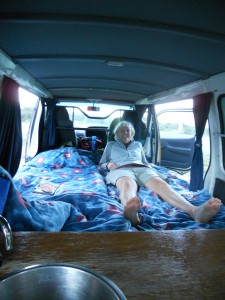
For the last six months, Krista had been traveling around the world, taking some time for herself. For me, it had been well over a year since I had sold my house and hit the road. Now that we were here, beside a lake in New Zealand, we found ourselves nesting. We cooked dinner and put sheets on the bed.   We evaluated our provisions and did the dishes. Then we settled in to watch the sun set over the camp while we played cribbage and drank tea. When we finally turned in it was with rib-crushing hugs, and friendly snuggles, both of us grateful for the beauty around us, and also for the bonus that comes with shared experience. Grateful for the time in the future when we would turn to each other and say, “you remember our first night in New Zealand?â€
January 4, 2011 1 Comment
Porters
We woke at 3:30 to the sound of our porters, “knocking” on the tent. “Coca tea, coca tea…” Handed through the rain fly and sleepily consumed, the tea woke us and prepared us for the climb ahead.
An hour later, we were running down the ancient Inka Trail, racing the sun on its path to the horizon. Our goal was the Sun Gate, as we ran in the dark, 30lb pack, headlamp, trekking poles and a 1,000 foot drop to one side.
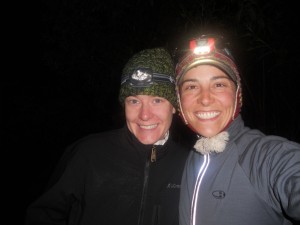
“I think I need more adventure racing in my life,” I thought to myself, a grin and a cackle rising to my mouth.
We’d spent the day before running down the 2,000+ steps from Deadwoman’s Pass. LeAnna and I were convinced now that it was easier than walking. From a perch high in the Andes, looking out over the cloud forest, we surveyed what lay ahead of us.
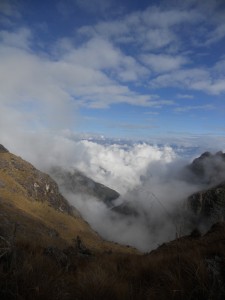
We’d climbed to a point that was undeniably sacred. The mist washed over the place, muffling voices, disorienting, transporting.
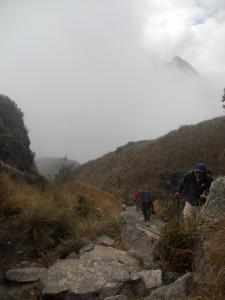
We stayed a short time, climbing as high as we could. We sat in silence, taking in the peaks that surrounded us; breathing in the strength of the ancient mountains. When we departed, it was quietly, leaving a small offering.
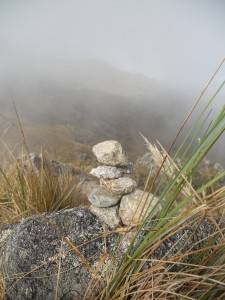
Once off the peak, we found ourselves in another world. Our surroundings changed from the high-steppe of the cloud forest to the damp, lush overgrowth of the rain forest, marked abruptly as the path dipped below the canopy before us.
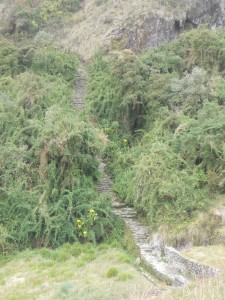
Always we were walking down. Down the sloping path, down the stone steps, down, down, down we trotted, undoing the work we’d done the day before.
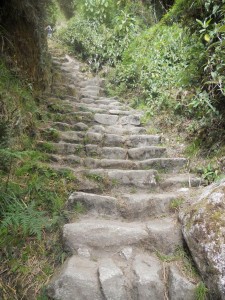
We stepped aside when we heard the padding of feet, and “porters†gently called to us.
In their sandals made of recycled tires, showing dry, calloused heels and blackened nails, the porters had an amazing mastery of the trail. Muscled calves bulged under the weight of impossible loads: canvas sacks fitted with shoulder straps and stacked high with tents and camp chairs, gas tanks and burners, cookware and tarps. Most bags were as tall as their porters, and always wider. The men often ran with their hands behind them, supporting the underside of their packs, waist belts ignored and hanging uselessly.
On this third day of our trek, we were feeling good. We looked at each other and, instead of hanging back like we had for two days, we fell in line behind a group of the small, weathered men.
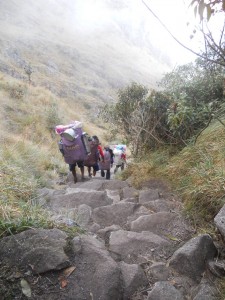
It’s a marvelous thing to find yourself traveling with a companion who shares your sensibilities. Without a word, we decided to see if we could hang with these porters. And so we ran, indelicately down the path.
It must have startled at least one of the porters. Hearing our scuffling, he stood aside for us to pass, a bemused look on his face.
“No, no!†We waved our arms at him, beckoning him on in front of us. It was one thing to run behind the porters, but quite another to run in front of them. So we stayed behind, watching as they slid around hairpin turns and cut off the trail to take nearly invisible shortcuts.
For two hours, we ran. We kept the porters within earshot nearly the entire time. Only in the last 10 minutes before camp were we passed by others. We felt good. We celebrated as we came around the corner and saw the green and yellow of our porters’ food tent, and the surprised looks on their faces.
The surprise turned to smiles as they clapped for us. And then they set to work. We were indeed a surprise. The sleeping tents weren’t yet set, and the food was far from ready. These guys had only just arrived before we had. Guilt joined our emotions as we watched them scramble to set camp – something they clearly hadn’t planned on having to do for a while.
We slept early and hard that night, knowing the ungodly hour at which we’d be expected to rise. But not before we’d gone through an elaborate ceremony designed specifically to allow us to tip our new friends. Francisco, their spokesman and shaman spoke to us, calling us “brother†and “sister†and talking of the connection that all of us share.
For our part, we thanked them in Spanish, as well as we could. I thanked them for everything, “todo,†which was heard as “toro,†or bull. One of many misunderstandings…and then we tipped each of them according to their job description from a pool of money we had all gathered together – an attempt to say thank you for the backbreaking work they did, and the cultural heritage they shared with us.
* * *
Day 4 had started at 3:30 a.m. for a couple of reasons. We had to hike half a mile up the trail to wait at the last checkpoint with the hundreds of other trekkers who wanted to make the Sun Gate before sunrise. It meant sitting at the checkpoint for an hour and a half, but it also meant having relatively few people in front of us on the trail.
The other reason was to allow the porters to run the 90 minutes down to their 6 a.m. train that would take them back home. They would be leaving us to go on to Machu Picchu alone. I asked Odon how many of the porters had ever seen the sacred site.
“None of them.â€Â Our guide seemed amused by the question. It cost money to see the site, and the porters had to catch the train back far too early to allow them to venture on. Odon had spent years as a porter, running the trail 4 times a week. After years studying “hospitality services,†he was now a guide. He wore hiking boots and carried only a small pack with his personal items. He would be entering Machu Picchu as our guide. The other Peruvians would be running with all of their might to catch a train so that they could prepare for the next day’s brutal return to the trail.
It’s a humbling thing to realize your privilege. To sit in the mud, having paid for the opportunity to do so. Waiting to see the cultural heritage of a people that carried my food so that I could see something that they never would – the sites created by their ancestors.
Dressed in the freshest clothes we had, we marinated in our adrenaline, willing the checkpoint to open. When it did, we found ourselves in an adventure park setting. Something between Disneyland and Jurassic Park surrounded us. One misstep could seriously send us hurtling down hundreds of feet of drop-off.
There were only a couple dozen trekkers in front of us. LeAnna and I had angled to the front of our group, eager to continue our running of the trail. But this section was narrow, and didn’t provide much opportunity for passing. Eventually, we made it to the front, moving past people who stopped to tie shoes or drink water. We were possessed.
Only once did we stop – to remove layers rendered unnecessary by our running. Neither of us wanted to find ourselves sweating and chilled in the early morning cold. While we stripped with lightning speed, one small group of two passed us. We swore under our breath and redoubled our efforts. We knew we were close, but we didn’t realize just how close. The Sun Gate was at the top of the “ladder,†a series of steep steps.
As soon as we resumed our jog, we hit them.
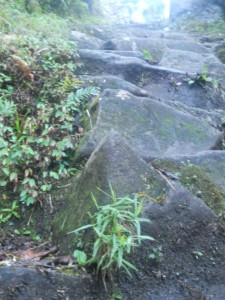
“Steep†didn’t quite describe them. We climbed, hands and feet, up the nearly vertical rocks. I struggled, my pack weighing heavy, as I heard heavy breathing behind me. I toppled backward once, reaching out and grasping at the rocks, saving myself and the people behind me. LeAnna and I built a wall, climbing side-by-side so that we would reach the top without being passed again. (Like I said, possessed.)
And then we were there. At the Sun Gate. With almost nobody around, we surveyed the view. It was cloudy. There would be no sunrise for us. But it made no real difference. We stood at the top and looked through the mist at the bits and pieces of landscape that were revealed.

The rest of our group materialized, and we posed for our second mandatory group shot.
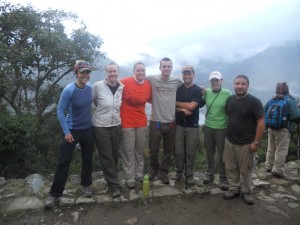
One more hike, and we’d be at our destination – a place that had eluded Spanish conquests. A place that is still not completely understood. A place secret, and sacred and hidden.
The trail led on, past sacred rocks and through parts that had been washed out by mudslides.
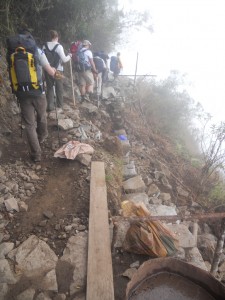
The closer we got, the reasons it had remained secret became more and more clear.
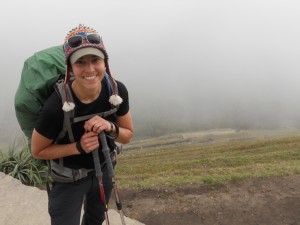
The enormous site of Machu Picchu lay hidden in the mist. It was right in front of us, and we had almost no indication that it existed.

“Secret and sacred,†Odon had intoned. As we watched the swirling mists, we began to see.
November 24, 2010 1 Comment


